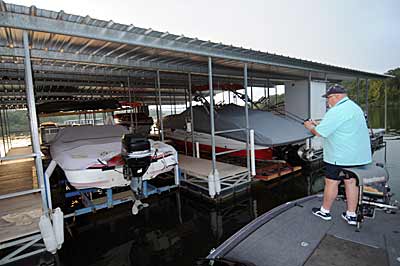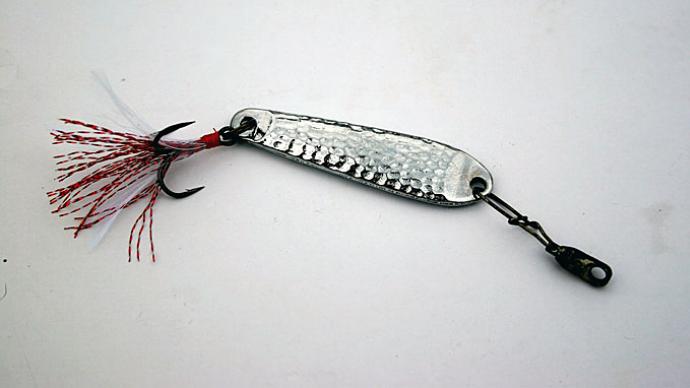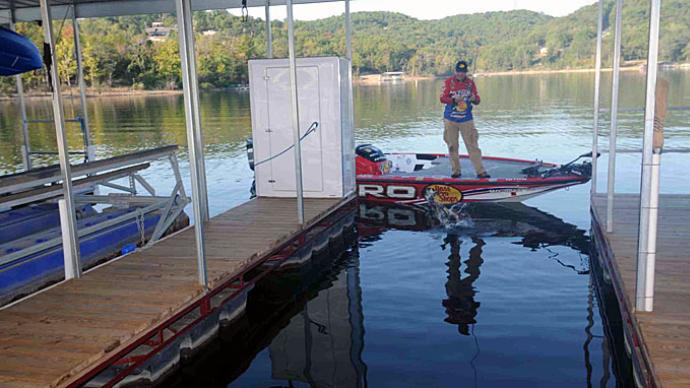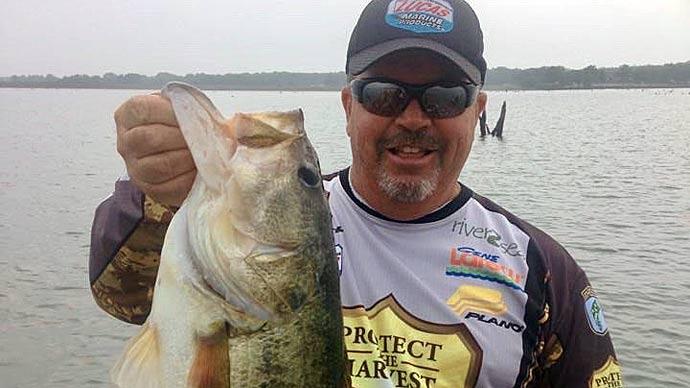
Veteran tournament angler Tom Murphy likes to spoon-feed bass during late summer.
The Dixie Jet Lures Company owner serves bass flutter spoons and slab spoons when the fish start attacking shad balls in late summer. “The shad are starting to bunch up in bigger balls getting ready for fall,” Murphy says. “The water temperature is cooling down a little bit, and the bass get more active. The gizzard shad are starting to get bigger, and the bass love to feed on gizzard shad.”
Murphy believes his spoons replicate shad and will catch bass on any lake where the baitfish are prevalent. His company offers a 7/8-ounce Slab Spoon and a line of flutter spoons ranging from the 2 1/4-inch Flutter Spoon to the 6-inch Talon and Big Daddy spoons.
The flutter spoon is Murphy’s choice when bass are crashing through balls of shad in open water or standing timber. “It’s just a fun bait to fish,” Murphy says. “You throw it out there, and it looks like an injured shad as it flutters down. The bigger bass will sit under the shad ball and wait for the injured shad to fall. That makes the Dixie Jet so good because it looks like a dying shad, and the bigger bass just sit down there and pick it off.”
Murphy advises you will get more strikes if you fish with a quality spoon. “I don’t like a spoon made out of tin,” he says. “Our spoons are made out of marine grade brass which has a better feel and fall rate. When it strikes things like trees and cables, it has a unique sound when it hits those things.
“You want a spoon with a nice flutter,” Murphy says. “You don’t want the spoon to take forever to get down in the water and just sit there and float because that is just not natural.”
The Missouri angler opts for spoons in 1/2-ounce, and 3/4-ounce sizes, which he believes are the optimal weights for flutter spoons. He mostly opts for the 3/4-ounce size because it sinks quicker through the shad ball down to the larger lazy bass looking for an easy meal to flutter down to them. The 1/2-ounce spoon works best for Murphy when he fishes shallower water (around 20 feet deep) or when he wants his spoon to fall slower through larger balls of shad. His favorite colors for the flutter and slab spoons are white and silver.

Murphy works his flutter spoon with a 7- or 7 1/2-foot medium-heavy action rod with a fast tip and a 6.4:1 or higher gear ratio baitcast reel filled with 10- or 12-pound Seaguar fluorocarbon line. He will fish the flutter spoon in depths ranging from 20 to 70 feet.
The versatility of the flutter spoon allows Murphy to retrieve the bait in a variety of ways. “If there are schooling fish, I will cast the flutter spoon out to where they are schooling and won’t even engage my reel,” he says. “I will let the spoon free fall and watch my line to see it twitch (indicating a strike). If I am fishing the timber, such as submerged cedar trees (in 45 to 55 feet of water), I will make a long cast and count it down five seconds or eight seconds or whatever to get it down there. I will point my rod tip towards that spoon, take one or two quick cranks of the reel, and then pause. What that does is causes the spoon to jerk and swim like it is coming out of the trees, and then when you pause it, it looks like a dying shad fluttering down.” Murphy retrieves the spoon with the crank-and-pause tactic back to the boat because the spoon draws bass out of the trees to hit the lure.
Stroking the spoon along flats is another productive flutter spoon retrieve for Murphy. “I just start ripping it off the bottom and then let it flutter back,” he says.

The slab spoon is Murphy’s choice on hot sunny days. “Sunlight drives bass into shady areas,” Murphy says. “I like to throw these spoons on sea walls, breaker walls (wave breaks), the front edges of docks and inside of docks. When it is sweltering and sunny, those bass will get in the middle of the docks.”
Murphy flips the slab spoon to the docks with a 6 1/2-foot or 6-foot, 8-inch medium-heavy casting rod with a fast tip and a 6.4:1 or 7.1:1 gear ratio baitcast reel filled with 20- or 25-pound Seaguar fluorocarbon. He pitches the spoon under the boats on the boat lifts or between the lifts and the dock floatation. After the spoon hits the water, Murphy keeps his reel bait open and watches his line for any movement that indicates a strike. “When the slab spoon hits the water, it will do a quick jerk to the left, then a quick jerk to the right, and then it kind of points to the bottom, and it fires down like a bullet,” Murphy says. “So if there are bass suspended 2 to 3 feet underneath the floatation of a dock and they see that spoon zig and zag and all of a sudden turn and start falling, they are going to chase it and kill it.”
Murphy will let the spoon drop to the bottom if he fails to get a bite on the fall. Then he jerks it off the bottom and pauses the spoon to let it fall again to trigger strikes.
Murphy knows the docks frequently hold large schools of bass, so he adds a Gamakatsu G-Stinger Trailer Hook above his slab spoon to catch doubles. The FLW pro recalls that the fastest limit he ever caught in a tournament was on a slab spoon with a stinger hook. “I made a drop and caught a double and swung them in the boat,” Murphy says. “My co-angler took them off and was putting them in the livewell when I grabbed my other rod, dropped the spoon in again, and quickly caught a single. I flipped that fish in the boat, grabbed my other rod, dropped the spoon back in there, and had a double again. It took me 14 minutes, and I had 14 1/2 pounds.”
Here is Murphy's video on spoon fishing:
BassResource may receive a portion of revenues if you make a purchase using a link above.




